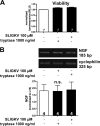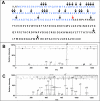Human tryptase cleaves pro-nerve growth factor (pro-NGF): hints of local, mast cell-dependent regulation of NGF/pro-NGF action
- PMID: 21768088
- PMCID: PMC3173076
- DOI: 10.1074/jbc.M111.233486
Human tryptase cleaves pro-nerve growth factor (pro-NGF): hints of local, mast cell-dependent regulation of NGF/pro-NGF action
Abstract
Several factors regulate nerve growth factor (NGF), which is formed from pro-NGF by intracellular and extracellular enzymatic cleavage. The close proximity between mast cells expressing the protease tryptase and NGF-producing smooth muscle-like peritubular cells in the testes of infertile patients led us to examine whether tryptase is among those factors. Human peritubular cells express functional tryptase receptors (PAR-2). Recombinant enzymatically active β-tryptase increased NGF levels in the culture medium of primary human peritubular cells, but the peptide agonist for PAR-2 (SLIGKV) did not. Neither tryptase nor the peptide increased NGF mRNA levels. To test whether the increase in NGF is due to enzymatic activity of tryptase acting on pro-NGF, supernatants of peritubular cells and synthetic pro-NGF were treated with tryptase. Results of Western blot studies indicate enzymatic cleavage of pro-NGF by active tryptase. Heat-inactivated tryptase or SLIGKV was not effective. Mass spectrometry analysis of in vitro cleavage products from recombinant tryptase and synthetic pro-NGF revealed multiple cleavage sites within the pro-NGF sequence. The results also indicate the generation of mature NGF and smaller NGF fragments as a result of tryptase action. Thus, tryptase-secreting mast cells in the vicinity of pro-NGF/NGF-secreting cells in any human tissue are likely able to alter the ratios of pro-NGF/NGF. As NGF and pro-NGF have different affinities for their receptors, this indicates a novel way by which mast cells, via tryptase, can modify the microenvironment in human tissues with regard to neurotrophin actions.
Figures






Similar articles
-
Nerve growth factor: a neuroimmune crosstalk mediator for all seasons.Immunology. 2017 May;151(1):1-15. doi: 10.1111/imm.12717. Epub 2017 Feb 21. Immunology. 2017. PMID: 28112808 Free PMC article. Review.
-
Are testicular mast cells involved in the regulation of germ cells in man?Andrology. 2014 Jul;2(4):615-22. doi: 10.1111/j.2047-2927.2014.00227.x. Epub 2014 Jun 12. Andrology. 2014. PMID: 24919455
-
Nerve growth factor-beta induces mast-cell marker expression during in vitro culture of human umbilical cord blood cells.Immunology. 2000 Mar;99(3):418-26. doi: 10.1046/j.1365-2567.2000.00984.x. Immunology. 2000. PMID: 10712672 Free PMC article.
-
Effects of nerve growth factor (NGF) and other fibroblast-derived growth factors on immature human mast cells (HMC-1).Immunology. 1998 Jul;94(3):310-7. Immunology. 1998. PMID: 9771435 Free PMC article.
-
Mast cell tryptase - Marker and maker of cardiovascular diseases.Pharmacol Ther. 2019 Jul;199:91-110. doi: 10.1016/j.pharmthera.2019.03.008. Epub 2019 Mar 12. Pharmacol Ther. 2019. PMID: 30877022 Review.
Cited by
-
New Insights into the Pathogenesis of Systemic Mastocytosis.Int J Mol Sci. 2021 May 5;22(9):4900. doi: 10.3390/ijms22094900. Int J Mol Sci. 2021. PMID: 34063170 Free PMC article. Review.
-
NGF and the Male Reproductive System: Potential Clinical Applications in Infertility.Int J Mol Sci. 2022 Oct 28;23(21):13127. doi: 10.3390/ijms232113127. Int J Mol Sci. 2022. PMID: 36361912 Free PMC article. Review.
-
Age-Related Alterations in the Testicular Proteome of a Non-Human Primate.Cells. 2021 May 24;10(6):1306. doi: 10.3390/cells10061306. Cells. 2021. PMID: 34074003 Free PMC article.
-
Local Actions of Melatonin in Somatic Cells of the Testis.Int J Mol Sci. 2017 May 31;18(6):1170. doi: 10.3390/ijms18061170. Int J Mol Sci. 2017. PMID: 28561756 Free PMC article. Review.
-
Nerve growth factor: a neuroimmune crosstalk mediator for all seasons.Immunology. 2017 May;151(1):1-15. doi: 10.1111/imm.12717. Epub 2017 Feb 21. Immunology. 2017. PMID: 28112808 Free PMC article. Review.
References
Publication types
MeSH terms
Substances
LinkOut - more resources
Full Text Sources
Other Literature Sources
Research Materials

